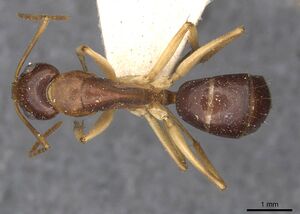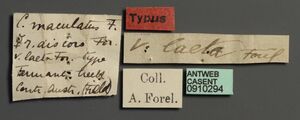Camponotus discors
| Camponotus discors | |
|---|---|

| |
| Scientific classification | |
| Kingdom: | Animalia |
| Phylum: | Arthropoda |
| Class: | Insecta |
| Order: | Hymenoptera |
| Family: | Formicidae |
| Subfamily: | Formicinae |
| Tribe: | Camponotini |
| Genus: | Camponotus |
| Species: | C. discors |
| Binomial name | |
| Camponotus discors Forel, 1902 | |
| Subspecies | |
| |
Identification
Keys including this Species
- Key to Australian Camponotus majors of the southwestern Botanical Province
- Key to Australian Camponotus minors of the southwestern Botanical Province
- Key to Australian Camponotus species
Distribution
Latitudinal Distribution Pattern
Latitudinal Range: 22.5045° to -35.50386°.
| North Temperate |
North Subtropical |
Tropical | South Subtropical |
South Temperate |
- Source: AntMaps
Distribution based on Regional Taxon Lists
Australasian Region: Australia (type locality).
Distribution based on AntMaps
Distribution based on AntWeb specimens
Check data from AntWeb
Countries Occupied
| Number of countries occupied by this species based on AntWiki Regional Taxon Lists. In general, fewer countries occupied indicates a narrower range, while more countries indicates a more widespread species. |

|
Estimated Abundance
| Relative abundance based on number of AntMaps records per species (this species within the purple bar). Fewer records (to the left) indicates a less abundant/encountered species while more records (to the right) indicates more abundant/encountered species. |

|
Biology
Castes
Images from AntWeb
   
| |
| Syntype of Camponotus discors. Worker (major/soldier). Specimen code casent0910290. Photographer Z. Lieberman, uploaded by California Academy of Sciences. | Owned by MHNG, Geneva, Switzerland. |
   
| |
| Syntype of Camponotus discors. Worker. Specimen code casent0910291. Photographer Z. Lieberman, uploaded by California Academy of Sciences. | Owned by MHNG, Geneva, Switzerland. |
   
| |
| Syntype of Camponotus discors angustinodus. Worker (major/soldier). Specimen code casent0910292. Photographer Z. Lieberman, uploaded by California Academy of Sciences. | Owned by MHNG, Geneva, Switzerland. |
   
| |
| Syntype of Camponotus discors angustinodus. Worker. Specimen code casent0910293. Photographer Z. Lieberman, uploaded by California Academy of Sciences. | Owned by MHNG, Geneva, Switzerland. |
   
| |
| Syntype of Camponotus discors laetus. Worker (major/soldier). Specimen code casent0910294. Photographer Will Ericson, uploaded by California Academy of Sciences. | Owned by MHNG, Geneva, Switzerland. |
    
| |
| Syntype of Camponotus discors yarrabahensis. Worker (major/soldier). Specimen code casent0910295. Photographer Will Ericson, uploaded by California Academy of Sciences. | Owned by MHNG, Geneva, Switzerland. |
     
| |
| Syntype of Camponotus discors yarrabahensis. Worker. Specimen code casent0910296. Photographer Will Ericson, uploaded by California Academy of Sciences. | Owned by MHNG, Geneva, Switzerland. |
Nomenclature
The following information is derived from Barry Bolton's Online Catalogue of the Ants of the World.
- discors. Camponotus maculatus st. discors Forel, 1902h: 497 (s.w.) AUSTRALIA (New South Wales).
- Type-material: syntype major and minor workers (numbers not stated).
- Type-locality: Australia: New South Wales, Pera Bore (W.W. Froggatt).
- Type-depositories: ANIC, MHNG.
- Combination in C. (Myrmoturba): Forel, 1915b: 99; Wheeler, W.M. 1915g: 814;
- combination in C. (Tanaemyrmex): Emery, 1925b: 102.
- Subspecies of maculatus: Forel, 1907h: 299; Forel, 1910b: 70; Emery, 1914b: 180; Forel, 1915b: 99; Wheeler, W.M. 1915g: 814.
- Status as species: Emery, 1920c: 8; Emery, 1925b: 102; Taylor & Brown, 1985: 113; Taylor, 1987a: 12; Bolton, 1995b: 96; McArthur, 2007a: 335; Heterick, 2009: 69; McArthur, 2014: 148.
- Distribution: Australia.
- Current subspecies: nominal plus laetus, yarrabahensis.
Type Material
- Camponotus maculatus discors Forel, 1902: Syntype, worker, Pera Bore, New South Wales, Australia, Australian National Insect Collection.
- Camponotus maculatus discors Forel, 1902: Syntype, 1 worker, Wooroloo, Western Australia, Australia, Western Australian Museum.
Unless otherwise noted the text for the remainder of this section is reported from the publication that includes the original description.
Description
Workers 7 to 10mm Major worker. Clypeus subcarined,lobe short and trapezoidal. Mandibles punctate, with a few striations. The head in the case of the major is almost as wide and convex as testaceipes of which it has the same form. A close neighbor of walkeri from which it differs especially by the presence of a lobe on the clypeus. The middle and posterior tibias have a range of strong spines. Pilosity is very sparse. The tibias and scapes are without erect hairs. The metanotum (= propodeum) has, as it were, 3 faces separated indistinctly by curves: a short basal face, then a median face in profile concave in the middle in the case of the major worker, then the declivity. The pronotum, mesonotum and basal face of the metanotum (= propodeum) form together a strong convexity. The node is of moderate thickness. Glossy and weakly shagreen. The head, except the occipital angles, the mesonotum and matanotum are a dark chestnut brown; the abdomen except the base and the occipital angles are a lighter brown; pronotum, node, tarses and antennae yellowish red; the rest of the limbs and the base of the gaster just as the front of the head in the minor worker, pale yellow. The minor worker has a rectangular head with a very distinct posterior border and it has very large eyes.
Pera Bore, N.S.Wales (Froggatt) This group constitute a transition from the group maculatus to the Australian group testaceipes, walkeri etc.
References
- Bolton, B. 1995b. A new general catalogue of the ants of the world. Cambridge, Mass.: Harvard University Press, 504 pp. (page 96, catalogue)
- Emery, C. 1920d. Studi sui Camponotus. Bull. Soc. Entomol. Ital. 52: 3-48 (page 8, raised to species)
- Emery, C. 1925d. Hymenoptera. Fam. Formicidae. Subfam. Formicinae. Genera Insectorum 183: 1-302 (page 102, combination in C. (Tanaemyrmex))
- Forel, A. 1902j. Fourmis nouvelles d'Australie. Rev. Suisse Zool. 10: 405-548 (page 497, soldier, worker described)
- Forel, A. 1915b. Results of Dr. E. Mjöbergs Swedish Scientific Expeditions to Australia 1910-13. 2. Ameisen. Ark. Zool. 9(1 16: 1-119 (page 99, combination in C. (Myrmoturba))
- Heterick, B.E. 2021. A guide to the ants of Western Australia. Part I: Systematics. Records of the Western Australian Museum, Supplement 86, 1-245 (doi:10.18195/issn.0313-122x.86.2021.001-245).
- Heterick, B.E. 2022. A guide to the ants of Western Australia. Part II: Distribution and biology. Records of the Western Australian Museum, supplement 86: 247-510 (doi:10.18195/issn.0313-122x.86.2022.247-510).
- Wheeler, W. M. 1915h. Hymenoptera. [In "Scientific notes on an expedition into the north-western regions of South Australia".]. Trans. R. Soc. S. Aust. 39: 805-823 (page 814, combination in C. (Myrmoturba))
References based on Global Ant Biodiversity Informatics
- Bisevac L., and J. D. Majer. 1999. Comparative study of ant communities of rehabilitated mineral sand mines and heathland, Western Australia. Restoration Ecology 7(2): 117-126.
- Gunawardene N.R. and J.D. Majer. 2004. Ants of the southern Carnarvon Basin, Western Australia: an investigation into patterns of association. Records of the Western Australian Museum 22: 219-239.
- Heterick B. E. 2009. A guide to the ants of south-western Australia. Records of the Western Australian Museum Supplement 76: 1-206.
- Heterick B. E. 2013. A taxonomic overview and key to the ants of Barrow Island, Western Australia. Records of the Western Australian Museum Supplement 83: 375-404.
- Heterick B. E., B. Durrant, and N. R. Gunawardene. 2010. The ant fauna of the Pilbara Bioregion, Western Australia. Records of the Western Australian Museum, Supplement 78: 157-167.
- Majer J. D., S. K. Callan, K. Edwards, N. R. Gunawardene, and C. K. Taylor. 2013. Baseline survey of the terrestrial invertebrate fauna of Barrow Island. Records of the Western Australian Museum Supplement 83: 13-112.
- Taylor R. W. 1987. A checklist of the ants of Australia, New Caledonia and New Zealand (Hymenoptera: Formicidae). CSIRO (Commonwealth Scientific and Industrial Research Organization) Division of Entomology Report 41: 1-92.
- Wheeler W. M. 1915. Hymenoptera. [In Scientific notes on an expedition into the north-western regions of South Australia.]. Transactions of the Royal Society of South Australia 39:805-823.

